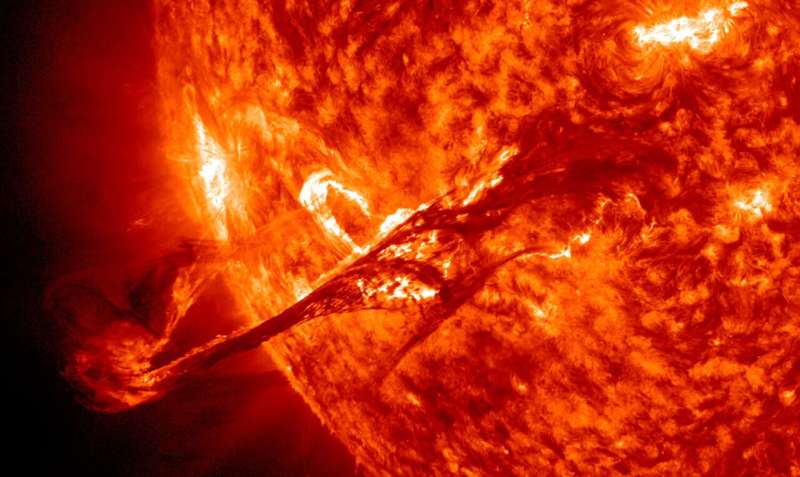
The Northern Lights were visible much farther south than usual this year, and pictures of the colorful hues filled social media. Now, imagine an aurora hundreds of times brighter—except no one would be able to snap a photo of it, as the onslaught of particles rushing in from the sun would instantly turn smartphones into bricks.
Such extreme solar storms are rare—only six are known to have left their traces on Earth in the past 14,500 years, and none have been witnessed since the height of the Assyrian Empire nearly 2,700 years ago.
A research team led by Irina Panyushkina of the University of Arizona Laboratory for Tree-Ring Research and Timothy Jull at U of A Department of Geosciences has now pinpointed the last time there was a burst of cosmic radiation so powerful that if it happened today, it would wreak havoc on power grids, satellites and communication networks around the globe.
The team published the findings in the journal Communications Earth & Environment.
Analyzing tree-rings for carbon-14, a naturally occurring radioactive variant of carbon, the team discovered a spike dating to the year 664 B.C., pinpointing the only extreme solar storm event whose timing had long eluded researchers.
Panyushkina, lead study author and a research associate professor of dendrochronology at the Laboratory for Tree-Ring Research, said determining the precise timing of a massive solar eruption event provides important data for scientists who study and develop models of the sun’s activity over time.
Carbon-14 continually forms in the atmosphere as a result of cosmic radiation, Panyushkina said. Eventually, carbon-14 reacts with oxygen to form carbon dioxide.
“After a few months, carbon-14 will have traveled from the stratosphere to the lower atmosphere, where it is taken up by trees and becomes part of the wood as they grow,” Panyushkina said.
It wasn’t until 2012 that extreme solar storms, known as Miyake events, were known to exist. That year, Fusa Miyake, a Japanese physicist and collaborator of Panyushkina’s team, published a paper reporting the storms’ telltale signature: spikes in radioactive carbon isotopes in the growth rings of trees.
Miyake events happen when the sun’s electromagnetic field weakens, allowing plasma from the sun’s surface to escape into space. With the increased solar activity, protons bombard Earth’s atmosphere and trigger chemical reactions leading to a spike in radioactive isotopes.
“Thanks to radiocarbon in tree-rings, we now know that six Miyake events happened over the last 14,500 years,” Panyushkina said. “If they happened today, they would have cataclysmic effects on communication technology.”
Panyushkina and her team used surgical knives to dissect individual tree rings from ancient wood samples, including samples from dead trees buried in riverbanks and timbers excavated during archaeological digs. The researchers then burned the cellulose—the main component of wood—to determine the radiocarbon content.
Discover the latest in science, tech, and space with over 100,000 subscribers who rely on Phys.org for daily insights.
Sign up for our free newsletter and get updates on breakthroughs,
innovations, and research that matter—daily or weekly.
To pinpoint whether solar storms caused the radiocarbon spikes, the researchers compared the tree-ring data to spikes other researchers found in a different isotope, beryllium-10, locked in ice cores taken from glaciers and ice sheets. Much like carbon-14, beryllium-10 forms in the atmosphere due to an onslaught of particles from the sun. Rain and snow capture the isotope and lock it into ice sheets similar to how trees absorb carbon-14.
“If ice cores from both the North Pole and South Pole show a spike in the isotope beryllium-10 for a particular year corresponding to increased radiocarbon in tree-rings, we know there was a solar storm,” Panyushkina said.
Although tree-rings can act like “archivists” recording Miyake events, researchers so far have not been able to find evidence of a pattern in the events, Panyushkina said.
“Tree-rings give us an idea of the magnitude of these massive storms, but we can’t detect any type of pattern, so it is unlikely we’ll ever be able to predict when such an event is going to happen,” she said. “Still, we believe our paper will transform how we search and understand the carbon-14 spike signal of extreme solar proton events in tree rings.”
“The energy from this type of event not only changes the atmosphere’s radiocarbon content but also the atmosphere’s chemistry,” she added. “We are trying to figure out how those short-lived and powerful events affect the Earth system as a whole.”
More information:
Irina P. Panyushkina et al, The timing of the ca-660 BCE Miyake solar-proton event constrained to between 664 and 663 BCE, Communications Earth & Environment (2024). DOI: 10.1038/s43247-024-01618-x
Journal information:
Communications Earth & Environment
Provided by
University of Arizona
Researchers probe ancient wood for clues about massive solar storms (2024, November 21)
retrieved 21 November 2024
from https://phys.org/news/2024-11-probe-ancient-wood-clues-massive.html
part may be reproduced without the written permission. The content is provided for information purposes only.